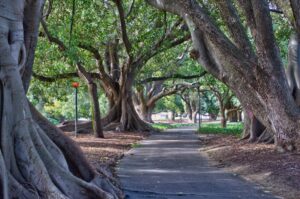The Complete Guide to Protected Trees in the UK: What You Need to Know
In the verdant landscapes of the United Kingdom, trees stand as silent sentinels, bearing witness to centuries of history and providing invaluable ecological services. The protection of these arboreal treasures has become increasingly important as urban development and climate change continue to threaten our natural heritage. If you own property with trees or are considering purchasing land with existing trees, understanding the complex web of regulations surrounding protected trees is essential to avoid legal complications and potential financial penalties.
This comprehensive guide aims to demystify the concept of protected trees in the UK, offering practical advice and detailed information to help you navigate the legal landscape with confidence. From identifying different types of protection orders to understanding your responsibilities as a landowner, we’ll explore everything you need to know about protected trees in the United Kingdom.
Understanding Tree Preservation Orders (TPOs)
Tree Preservation Orders (TPOs) represent one of the most common forms of legal protection for trees in the United Kingdom. Established under the Town and Country Planning Act 1990, these orders are implemented by local planning authorities to safeguard trees that contribute significantly to public amenity and environmental wellbeing.
What Exactly Is a TPO?
A Tree Preservation Order is a legal mechanism used by local councils to protect specific trees, groups of trees, or woodlands that offer significant amenity value to the local area. When a tree is covered by a TPO, it becomes an offense to cut down, top, lop, uproot, willfully damage, or willfully destroy the tree without first obtaining permission from the local planning authority.
TPOs can be applied to any species of tree and can protect individual specimens, groups, areas, or entire woodlands. They cannot, however, be used to protect shrubs, bushes, or hedges. The principal aim of a TPO is to preserve trees that contribute to the character and appearance of an area, ensuring they remain for future generations to enjoy.
According to data from the Forestry Commission, thousands of TPOs are currently in force across the UK, protecting millions of trees from unnecessary damage or removal. The following table provides an overview of the geographical distribution of TPOs across different regions of the United Kingdom:
| Region | Approximate Number of TPOs | Estimated Trees Protected |
|---|---|---|
| England | 22,500 | 1.8 million |
| Scotland | 5,800 | 650,000 |
| Wales | 3,200 | 420,000 |
| Northern Ireland | 2,100 | 280,000 |
Source: Data compiled from various local authority reports and Forestry Commission statistics
How to Check if a Tree Has a TPO
If you’re uncertain whether a tree on your property or a tree you’re interested in is protected by a TPO, you can check with your local planning authority. Most councils maintain a register of TPOs that is available for public inspection, either in person at council offices or online through their official websites.
You can also request a search as part of the conveyancing process when purchasing property. This search will reveal any TPOs affecting trees on the land you’re buying, allowing you to understand your obligations before completing the purchase.
For immediate reference, you can visit the UK Government Planning Portal, which provides guidance on checking the status of trees and understanding the implications of various protection orders.
The Process of TPO Application and Enforcement
Local planning authorities typically follow a structured process when implementing a TPO. This begins with an assessment of the tree’s amenity value, considering factors such as its visibility to the public, its contribution to the local landscape, its rarity, and its historical or cultural significance.
If the authority determines that the tree merits protection, it will issue a provisional TPO, which takes immediate effect for six months. During this period, the authority will consult with affected landowners and other interested parties before deciding whether to confirm the order permanently.
Once confirmed, a TPO remains in force indefinitely, unless it is revoked by the local authority or modified through a formal variation process. Breaching a TPO without prior consent is a serious offense that can result in substantial fines. The maximum penalty for destroying a protected tree was significantly increased in 2012 to £20,000, reflecting the growing recognition of the importance of tree preservation.

Conservation Areas and Tree Protection
Beyond Tree Preservation Orders, trees can also receive protection through their location within designated Conservation Areas. These are areas of special architectural or historical interest, the character of which local authorities aim to preserve and enhance.
Trees in Conservation Areas: Special Considerations
If you own trees within a Conservation Area, you’re required to give six weeks’ notice in writing to the local planning authority before carrying out any work on them, even if they aren’t specifically covered by a TPO. This notification, known as a “Section 211 Notice,” allows the authority to assess the trees and decide whether they warrant the additional protection of a TPO.
During the six-week notice period, the trees are protected as if they were subject to a TPO, making it an offense to carry out work without permission if the authority decides to implement an order. This system ensures that potentially valuable trees aren’t lost through premature or ill-considered action.
The following table outlines the key differences between TPO protection and Conservation Area protection:
| Feature | TPO Protection | Conservation Area Protection |
|---|---|---|
| Prior notification needed for work | Yes – formal application required | Yes – six weeks’ notice required |
| Protection is specific to individual trees | Yes – identified in the order | No – blanket protection for all trees over 7.5cm diameter |
| Replacement planting requirement if tree removed | Yes – typically required | Only if subsequently protected by TPO |
| Duration of protection | Indefinite unless revoked | Ongoing while Conservation Area status remains |
| Maximum penalty for breach | Up to £20,000 | Up to £20,000 |
Source: Information compiled from the Town and Country Planning Act 1990 and associated regulations
According to the latest statistics from Historic England, there are currently over 10,000 Conservation Areas in the United Kingdom, encompassing approximately 2.2% of the country’s total land area. Within these protected zones, countless trees benefit from the additional layer of protection afforded by Conservation Area status.

How to Check if Your Property is in a Conservation Area
To determine whether your property falls within a Conservation Area, you can check with your local planning authority. Most councils maintain detailed maps of Conservation Areas on their websites, allowing you to search by address or postcode. Alternatively, you can contact the planning department directly for confirmation.
If you’re purchasing property, a standard local authority search conducted during the conveyancing process should reveal whether the property is situated in a Conservation Area. This information is crucial for understanding your obligations regarding any trees on the land.
Ancient and Veteran Trees: Special Protections
Among the most valuable arboreal assets in the UK landscape are ancient and veteran trees, which represent living connections to our historical past and provide irreplaceable habitats for countless species.
Defining Ancient and Veteran Trees
Ancient trees are those that have reached a significant age for their species – typically several centuries old – and exhibit characteristics such as a wide trunk, hollow interior, and reduced crown. They’re living relics of historical landscapes and often hold cultural significance beyond their ecological value.
Veteran trees, while not necessarily as old as ancient specimens, display features associated with aging, such as dead wood, cavities, and fungal growths. These features make them particularly valuable for biodiversity, providing microhabitats for a wide range of organisms.
The Ancient Tree Inventory, maintained by the Woodland Trust, has recorded over 160,000 ancient, veteran, and notable trees across the UK, though experts estimate the true number to be considerably higher. The following table highlights some of the oldest recorded trees by species in the United Kingdom:
| Species | Location | Estimated Age (Years) | Girth (Meters) | Protection Status |
|---|---|---|---|---|
| Yew | St. Cynog’s Churchyard, Powys | 5,000+ | 10.75 | SSSI, Churchyard |
| Oak | Bowthorpe Oak, Lincolnshire | 1,000+ | 12.30 | TPO |
| Sweet Chestnut | Tortworth, Gloucestershire | 1,100+ | 11.38 | TPO, Historic England |
| Lime | Westonbirt Arboretum, Gloucestershire | 2,000+ | 7.90 | SSSI, National Arboretum |
| Scots Pine | Glen Loyne, Highlands | 550+ | 3.42 | National Scenic Area |
Source: Data compiled from the Ancient Tree Inventory and Various Conservation Reports
Legal Protections for Ancient Trees
Ancient and veteran trees can receive protection through various legal mechanisms, including TPOs, Conservation Area status, and designation as part of Sites of Special Scientific Interest (SSSIs). Additionally, the National Planning Policy Framework (NPPF) provides specific protection for ancient woodland and ancient or veteran trees, classifying them as “irreplaceable habitats.”
Paragraph 180 of the NPPF states that “development resulting in the loss or deterioration of irreplaceable habitats (such as ancient woodland and ancient or veteran trees) should be refused, unless there are wholly exceptional reasons and a suitable compensation strategy exists.” This creates a strong presumption against development that would harm these valuable natural assets.
If you’re fortunate enough to have ancient or veteran trees on your property, you should consult with your local authority and organizations such as the Woodland Trust or Natural England for advice on their appropriate management and conservation.
Applying for Permission to Work on Protected Trees
There may be legitimate reasons why you need to carry out work on a protected tree, such as safety concerns, disease management, or appropriate pruning to maintain the tree’s health. In such cases, you’ll need to obtain permission from your local planning authority before proceeding.
The Application Process
To apply for consent to work on a tree protected by a TPO, you’ll need to complete an application form provided by your local planning authority. This form typically requires detailed information about the tree, the work you’re proposing, and your reasons for wanting to undertake the work.
Most local authorities now offer online application systems, making the process more straightforward. The standard application form for tree works can be found on the UK Government Planning Portal. There is no fee for making an application relating to trees.
When preparing your application, it’s advisable to include:
- Clear identification of the tree(s) in question, preferably with reference to a plan or map
- A detailed description of the proposed work, including the specific branches to be removed or the extent of crown reduction
- Your reasons for proposing the work, supported by evidence where appropriate (e.g., arborist’s report for diseased trees)
- Photographs of the tree(s) and the surrounding area
- Any additional information that might support your case, such as evidence of structural damage or safety risks
The local planning authority will typically take up to eight weeks to make a decision on your application, during which time they may send an officer to inspect the tree and assess the proposed works.

Common Reasons for Permission and Refusal
Local authorities generally consider several factors when determining whether to grant permission for work on protected trees. Understanding these factors can help you frame your application appropriately and increase the likelihood of success.
Reasons that commonly lead to approval include:
- The tree is dead, dying, or dangerous
- The tree is causing significant structural damage to property
- The work is necessary to abate or prevent a nuisance
- The work is in the interests of good forestry practice
- The work will benefit the health and longevity of the tree
Conversely, applications are often refused when:
- The proposed work would significantly harm the tree’s appearance or compromise its contribution to public amenity
- The justification provided is deemed insufficient (e.g., minor or seasonal nuisances like leaf fall)
- There are alternative solutions that would avoid or minimize damage to the tree
- The work appears to be a prelude to development that hasn’t yet received planning permission
If your application is refused, you have the right to appeal to the Secretary of State within 28 days of receiving the decision. Information on the appeals process can be found on the Planning Inspectorate website.
Responsibilities and Liabilities of Tree Owners
Owning protected trees comes with both privileges and responsibilities. As a tree owner, you’re entrusted with the care and management of valuable natural assets, and this role carries certain legal obligations and potential liabilities.
Your Legal Duties as a Tree Owner
While TPOs and other protections restrict what you can do with your trees without permission, they don’t absolve you of responsibility for those trees. As a tree owner, you remain legally responsible for:
- Ensuring the trees don’t pose an unreasonable risk to people or property
- Maintaining the trees in a reasonably safe condition
- Addressing any issues that arise, such as disease or structural instability, through appropriate professional channels
- Complying with any statutory notices served by the local authority requiring specific works to be carried out
It’s important to note that these responsibilities apply regardless of whether the trees are protected. The presence of a TPO or Conservation Area status simply means that you need to obtain permission before undertaking work to fulfill these responsibilities.
To help you manage these obligations effectively, regular professional tree inspections are recommended, particularly for large or aging specimens. The frequency of these inspections will depend on the tree’s condition, species, location, and the level of risk it potentially poses.
Insurance and Liability Considerations
Trees can cause damage or injury in various ways, from falling branches to root-related subsidence. As a tree owner, you could potentially be held liable for such damage if it can be proven that you failed to take reasonable care of your trees.
Most standard home insurance policies include public liability coverage that may protect you against claims arising from tree-related incidents. However, it’s essential to check the specific terms of your policy and ensure that it provides adequate coverage for your circumstances.
If you’re aware of potential issues with your trees – for example, if an arborist has identified structural weaknesses or disease – it’s crucial to disclose this information to your insurer. Failure to do so could invalidate your coverage in the event of a claim.
For properties with significant or numerous protected trees, you might consider specialized insurance products that offer enhanced coverage for tree-related liabilities. A licensed insurance broker can provide guidance on the most appropriate options for your situation.
Exceptional Circumstances and Exemptions
While the protection of trees through TPOs and Conservation Area status is robust, there are certain situations in which works can be carried out without prior permission from the local planning authority.
Emergency Works and Exemptions
The Town and Country Planning (Tree Preservation) (England) Regulations 2012 outline several exemptions that allow work on protected trees without prior consent. These include:
- Works to a dead tree
- Works to remove an immediate risk of serious harm
- Works to implement a planning permission
- Works by or on behalf of certain statutory undertakers, such as utility companies
- Works to prevent or abate a nuisance (this has a specific legal meaning and doesn’t include common complaints like leaf fall or shade)
- Works to fruit trees cultivated for commercial fruit production
- Works by or on behalf of the Forestry Commission on land placed at their disposal
It’s important to note that even when carrying out exempt works, you should notify the local planning authority as soon as practicable, preferably before the work begins. This helps avoid misunderstandings and potential enforcement action.
The exemption for dead trees is particularly significant, as it allows for the timely removal of trees that may pose safety risks. However, you should be prepared to provide evidence that the tree was indeed dead if questioned by the authority.
Similarly, the exemption for trees presenting an immediate risk of serious harm should be interpreted narrowly. It applies only in genuine emergencies where the risk is both immediate and serious, not for general concerns about a tree’s condition or stability.
Dangerous Trees and Urgent Works
If you believe a protected tree poses an immediate danger, you should contact your local authority’s tree officer or planning department as soon as possible. Outside of office hours, many councils operate emergency services that can provide guidance on dealing with dangerous trees.
In truly urgent situations where there isn’t time to contact the authority, you may proceed with the minimum work necessary to make the tree safe. However, you should:
- Take photographs or gather other evidence of the danger before carrying out any work
- Keep samples of the damaged or diseased parts of the tree as evidence
- Notify the local planning authority in writing as soon as possible after the event, explaining the circumstances and providing your evidence
- Consider commissioning a report from a qualified arborist to support your actions
Remember that the burden of proving the exemption applies rests with you, so thorough documentation is essential. If the authority disputes your assessment of the situation, you could potentially face enforcement action and significant penalties.
Protected Trees and Development
The presence of protected trees can significantly impact development proposals, adding an additional layer of complexity to the planning process. If you’re considering development on land with protected trees, it’s essential to address tree protection issues early in your project planning.

Tree Surveys and Arboricultural Impact Assessments
Before submitting a planning application for development near protected trees, you’ll typically need to commission a tree survey and arboricultural impact assessment (AIA). These documents, prepared by qualified arborists, provide detailed information about the trees on site and assess how the proposed development might affect them.
A comprehensive tree survey should include:
- Identification of all trees on and adjacent to the site
- Assessment of each tree’s species, age, condition, and value
- Categorization of trees according to their quality and value (typically using the system outlined in British Standard BS5837)
- Recommendations for retention or removal based on arboricultural considerations
The arboricultural impact assessment builds on this information, analyzing:
- The direct impact of the development on trees (e.g., through required tree removal)
- Potential indirect impacts (e.g., encroachment into root protection areas)
- Proposed mitigation measures to minimize harm to retained trees
- Recommendations for replacement planting where tree loss is unavoidable
Together, these documents form a critical part of your planning application and demonstrate to the local authority that you’ve given proper consideration to the arboricultural implications of your proposals.
Planning Conditions and Tree Protection Plans
If planning permission is granted for development affecting protected trees, it will typically include conditions requiring the implementation of specific tree protection measures. These conditions are legally binding and must be complied with throughout the development process.
A tree protection plan (TPP) is often required as part of these conditions, detailing the practical measures that will be taken to safeguard trees during construction. This might include:
- The erection of protective fencing around root protection areas
- Specifications for any construction within root protection areas, such as specialized foundations or permeable surfacing
- Arrangements for arboricultural supervision during critical phases of work
- Protocols for site operations, such as materials storage and contractor parking, to avoid compaction of root areas
Failure to comply with planning conditions relating to tree protection can result in enforcement action by the local planning authority, potentially including stop notices, breach of condition notices, or even prosecution in serious cases.
For guidance on best practice in relation to trees and development, refer to British Standard BS5837:2012 ‘Trees in relation to design, demolition and construction – Recommendations’, which is recognized as the industry standard in this area.
Conclusion: Balancing Protection and Practical Management
Protected trees represent an important part of the UK’s natural and cultural heritage, providing ecological services, enhancing landscapes, and connecting us to our past. The legal frameworks that protect these valuable assets are designed to ensure their preservation for future generations while recognizing the legitimate needs of property owners and developers.
As a tree owner or land manager, understanding these frameworks is essential for making informed decisions about tree management and avoiding potential legal pitfalls. By working collaboratively with local authorities, professional arborists, and conservation organizations, you can develop approaches that balance protection with practical management, ensuring that our arboreal heritage continues to thrive.
Remember that protection doesn’t mean preservation at all costs – it means thoughtful stewardship that takes into account the multiple values and benefits that trees provide. With the right knowledge and support, you can play your part in this important work, contributing to a greener, more sustainable United Kingdom for generations to come.
For further information and guidance on protected trees, visit the UK Government’s guidance page on Tree Preservation Orders or contact your local planning authority’s tree officer.






